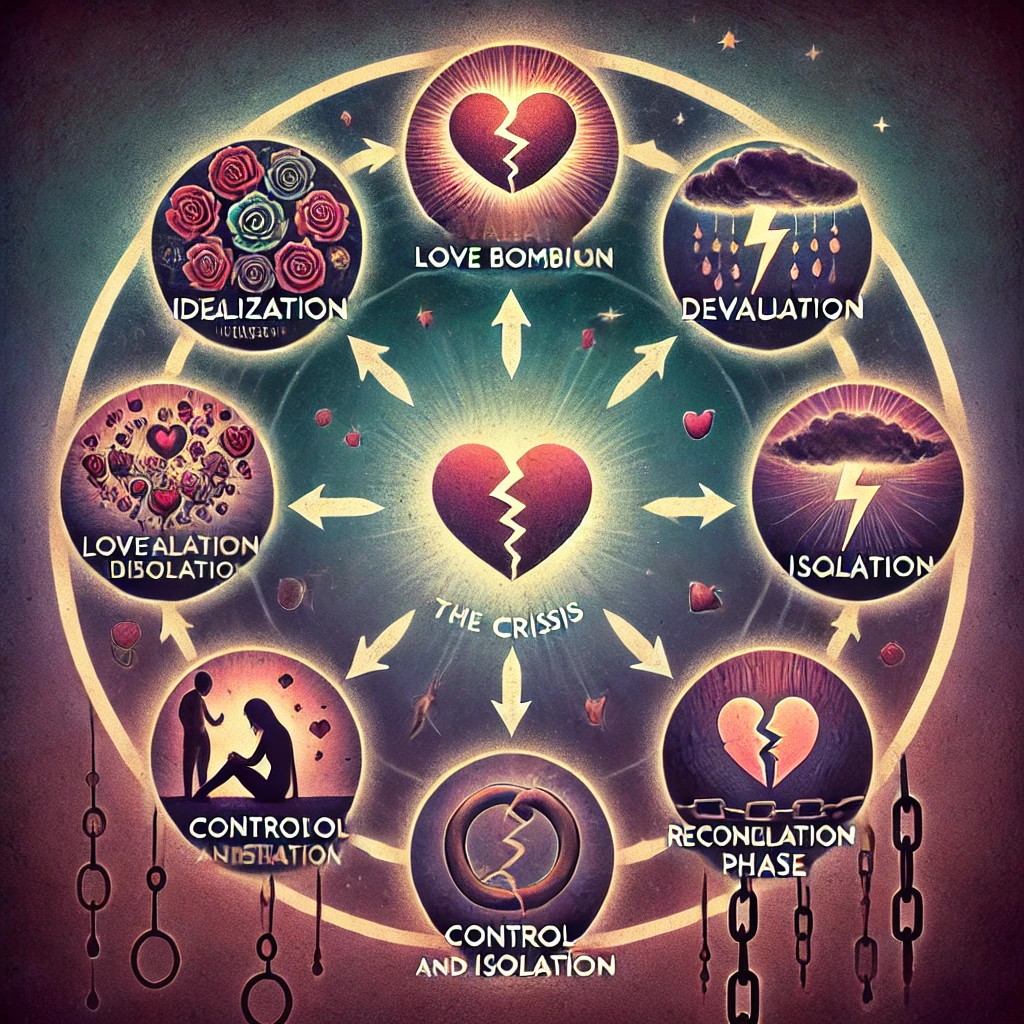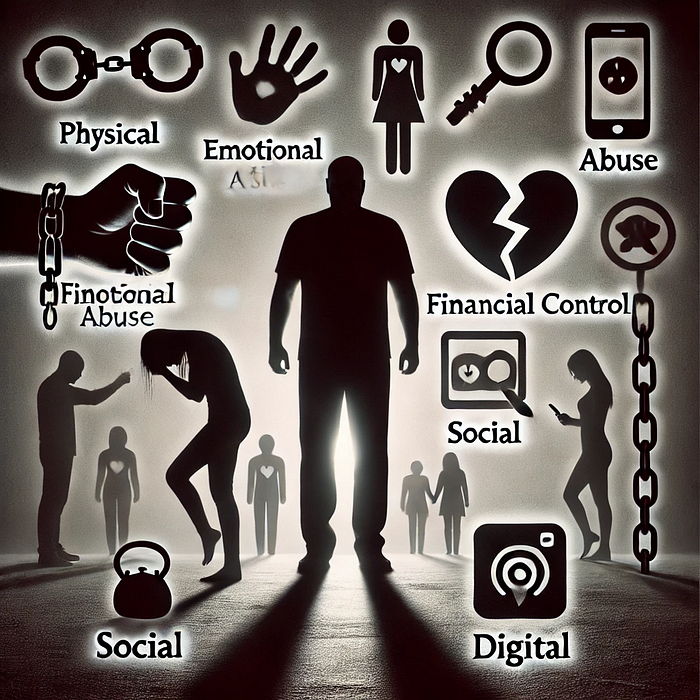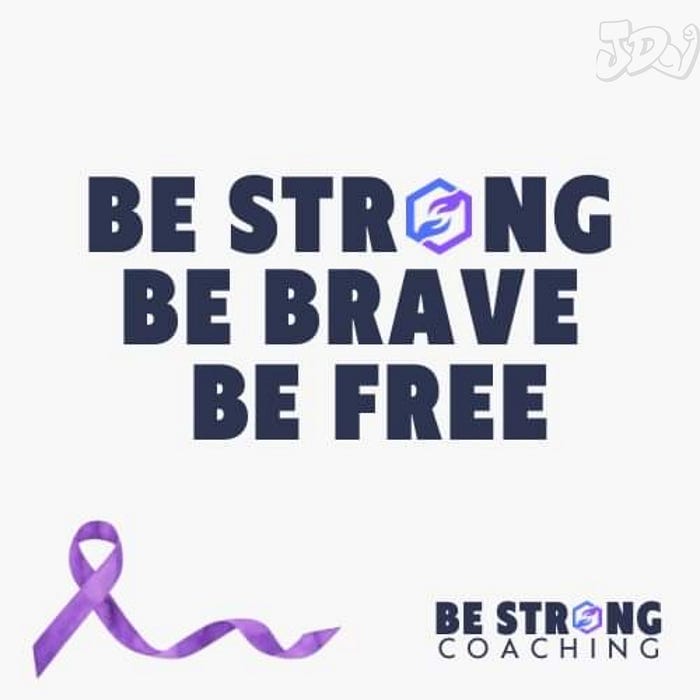
The Early Warning Signs of an Abusive Relationship
Building on the first article that introduced the different forms of domestic violence, this article will dive into the red flags that often appear early in abusive relationships. These warning signs are crucial to recognize because they often signal a larger pattern of control and manipulation to come.
Love Bombing and Future Faking
Overwhelming affection early in the relationship that creates an intense emotional bond. Alongside the future faking, the promise of the perfect partner, the promise of the happy ever after.

Grand Gestures
In the beginning, abusers frequently use grand gestures to overwhelm their partner. These gestures might include expensive gifts, extravagant dates, or overly romantic declarations of love. The abuser wants the victim to feel special and believe that they are entering a one-of-a-kind relationship. This tactic creates a sense of obligation and indebtedness in the victim, subtly manipulating them into feeling like they owe the abuser something in return. It’s also a way to fast-track intimacy, blurring the victim’s ability to notice potential red flags. We’ve all experienced it when we have our “love blinkers” on. Abusers prey on the one value that is one of our best and worst. Hope.
Hope as a Vulnerability
Hope is one of humanity’s greatest strengths but, in the hands of an abuser, it becomes a tool for manipulation. In these early stages, victims aren’t just swept off their feet by romantic gestures; they’re fueled by the hope that this relationship is the fulfillment of their dreams. This hope blinds them to inconsistencies or early signs of controlling behavior. When abusers make grand promises, the victim clings to the hope that the perfect future they envision will come true, even when the reality starts to show cracks.
Abusers exploit this, knowing that as long as the victim is holding onto hope, they are less likely to question the whirlwind speed of the relationship or challenge any discomfort they might be feeling. The victim may even rationalize early warning signs, convincing themselves that no one is perfect, and that love requires compromise. By weaponizing hope, abusers keep their victims emotionally invested long enough for the real abuse to begin.
Promises of a Perfect Future
Abusers often make grand promises about the future, painting an idealized picture of life together. They might talk about marriage, kids, or moving in together very early in the relationship. This future-faking creates a sense of security and excitement, making the victim invest emotionally and ignore their instincts about any warning signs. Abusers know that by giving the victim a vision of a dream future, they can hook them into staying even when the present becomes difficult.
This is also particularly effective on those who have been through DV before, and recently. Abusers will often seek out someone who has been in a DV relationship before.
Fast-Paced Relationship Development
Speed is a hallmark of the Idealization phase. Abusers often push for quick progression, like moving in together, getting engaged, or declaring their love within a few weeks. The rapid pace leaves little time for the victim to critically evaluate the relationship. Often not allowing sufficient alone time where the emotions settle down and you are able to replay events and look at them logically. Abusers may say things like “I’ve never felt this way before” or “I just know you’re the one,” pushing the victim to reciprocate feelings or commitments before they are ready. By accelerating the relationship, the abuser prevents the victim from seeing their true nature until they are already emotionally or physically invested.

The Psychological Impact
These tactics combine to create a potent emotional bond that is hard to break. The victim begins to believe that they’ve found something incredibly rare, which sets them up for confusion when the devaluation phase inevitably follows. Victims often cling to the memory of the grand gestures and promises, hoping that the abuser will revert to that loving, attentive person. This creates a cognitive dissonance, as the victim struggles to reconcile the initial perfect relationship with the escalating control and abuse.
Why It’s Dangerous
At first glance, the abuser’s intense affection, grand gestures, and promises of a perfect future may seem flattering. After all, who wouldn’t want to feel deeply loved and valued? But these tactics are designed to build emotional dependency quickly. The abuser creates an environment where the victim feels both cherished and obligated, making it difficult for them to pull away once control starts to creep in. By fast-tracking the relationship, the abuser leaves the victim little time to develop a clear sense of boundaries, which sets the stage for a trauma bond.
The Link to Trauma Bonding
Trauma bonding occurs when the abuser alternates between extreme kindness and cruelty, trapping the victim in a cycle of emotional highs and lows. In the Idealization phase, abusers shower the victim with love and attention, creating an emotional “high.” This makes the victim feel special, leading them to believe that they’ve found something rare and worth holding onto, even when the abuser begins to devalue or control them.
As the abuse escalates, the victim may find themselves holding onto the memory of the “good times” from the Idealization phase, convinced that if they just act the right way or endure long enough, they can return to that blissful period. The abuser reinforces this by occasionally throwing out small tokens of affection or promises of change, keeping the victim locked in place. The emotional whiplash between love and pain becomes addictive, trapping the victim in a cycle of trauma bonding that makes it incredibly hard to leave the relationship.
The long-term damage this causes is doubt and trust issues when someone comes along who is genuinely a loving, caring partner. The potential for pushing away or ruining a genuine relationship later, as a result, is devastating when trying to heal from trauma.
Long-Term Damage
The emotional toll of these manipulative tactics is profound. Over time, they erode the victim’s ability to trust, not only in others but in themselves. Victims often emerge from abusive relationships with deep-seated doubt and confusion about their own judgment. When someone genuinely loving and caring comes along later, it can be difficult to recognize or accept that person’s authenticity. The victim may find themselves pushing away a healthy relationship, afraid of being hurt again, or even sabotaging it unconsciously as a form of self-protection.
This fear of repeating the past can be devastating when trying to heal from trauma. The weight of past manipulation can cast a shadow over future relationships, making it hard to trust the intentions of others. Victims may struggle with feelings of unworthiness or feel that they are too damaged for real love.
The Path to Healing
However, awareness is a crucial step toward healing. By understanding the tactics used by abusers and recognizing how trauma bonding has impacted them, victims can begin to rebuild their trust, first in themselves, and then in others. Healing from trauma is a process, but with the right support, it is possible to be open to a healthy relationship in the future. Learning to spot red flags early on, setting boundaries, and taking things at a pace that feels safe are all important tools that can help prevent a return to abusive dynamics.
Being aware of the emotional traps that led to past abuse allows survivors to empower themselves, ensuring they are better equipped to protect their hearts while still staying open to the possibility of love.

Testing Boundaries
Abusers don’t typically jump straight into overtly abusive behavior; they start small, testing how much control they can exert over their victim. This phase is often subtle, and the boundary-pushing is easily overlooked because the actions might seem insignificant at first. By pushing small boundaries early on, abusers can gauge how compliant their victim is and adjust their tactics accordingly.
Boundary testing often begins with seemingly harmless actions. The abuser may start by ignoring the victim’s preferences, such as dismissing their choice of restaurant or activity in favor of their own. They might offer small, controlling suggestions like commenting on the victim’s clothing choices, suggesting they “dress more conservatively” or “look sexier.” These remarks are often framed as caring advice, which makes them difficult to challenge without feeling rude or ungrateful. They are more often than not shaped as a back-handed compliment.
As the relationship progresses, the abuser may begin to control who the victim spends time with, discouraging friendships they feel threatened by or making negative comments about close friends and family. They might say things like, “I just don’t trust your friend; I don’t think she’s good for you,” planting seeds of doubt to isolate the victim slowly.
How to Spot It
The key to spotting boundary testing is recognizing patterns. While one small violation may seem insignificant, repeated small boundary pushes, especially if they are rationalized or downplayed by the abuser, should be a red flag. Abusers may brush off their behavior as “just trying to help” or accuse the victim of overreacting if they voice discomfort. Over time, these small violations escalate, giving the abuser greater control while making the victim feel increasingly dependent.
Red Flags You Shouldn’t Ignore — Jealousy, Control, and Inconsistency
Abusers often exhibit signs of extreme jealousy or controlling behavior early on, but they disguise these actions as care, concern, or protectiveness. These behaviors might feel flattering at first, but they can quickly evolve into more severe forms of control.
One of the first signs of abusive tendencies is a partner monitoring social activities. The abuser may start by asking innocent-seeming questions about the victim’s day-who they spent time with, where they went-but this can escalate into demands for constant check-ins or even tracking the victim’s location. Restricting access to friends and family is another common tactic. The abuser may try to isolate the victim by making them feel guilty for wanting to spend time with others or by convincing them that no one else cares about them as much as the abuser does.
Being overly possessive is also a red flag. Abusers might call or text obsessively or get angry when the victim doesn’t respond immediately. They may react disproportionately to interactions with others, accusing the victim of being flirtatious or unfaithful when no such behavior has occurred.
Perhaps one of the most confusing tactics abusers use is inconsistency-switching between extreme charm and hostility. One moment they might be excessively loving and affectionate, making grand gestures to “make up” for previous controlling behavior. The next moment, they might be distant, cold, or even angry, leaving the victim walking on eggshells, unsure of what caused the shift.
This inconsistency keeps the victim off-balance. When abusers are kind and charming, the victim clings to those moments, hoping they’ll last, which makes them more willing to overlook the negative behavior. It creates a cycle of emotional highs and lows that pulls the victim deeper into the relationship, forming part of the trauma bond.

Empower Yourself with Awareness
Recognizing these early red flags is essential to breaking the cycle of control and manipulation in an abusive relationship. While the tactics abusers use can be subtle and insidious, being aware of these patterns helps protect your boundaries and rebuild trust, both in yourself and others. Remember, it’s not just about spotting the signs, but also about empowering yourself to act on them.
If you’re interested in learning more, join our free educational Zoom call on Sunday, October 27th at 3 PM (Perth time), where we’ll dive deeper into recognizing abusive behaviors and building resilience in the face of trauma. This call is part of a series of discussions, and you’ll have a chance to ask questions and share your experiences in a safe and confidential space. This is a 100% no sales talk, guaranteed. Purely for sharing information and a safe place to talk. You can be an anonymous guest. Your privacy and safety is of the utmost importance.
Additionally, The Abuser’s Playbook series of articles will soon form part of a free ebook resource, offering you a comprehensive guide to identifying and escaping the tactics abusers use. This ebook will be available to all members of the Be Strong community as a tool to support your journey toward healing.
Take the first step by following me at Be Strong Coaching, and together, we can work toward a future of empowerment and strength.






